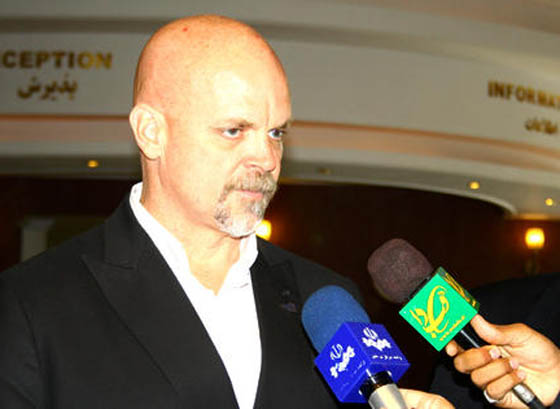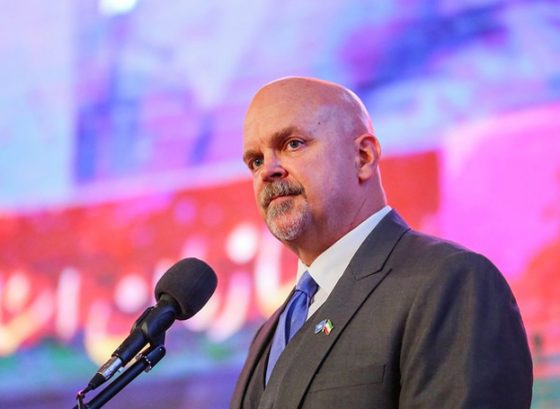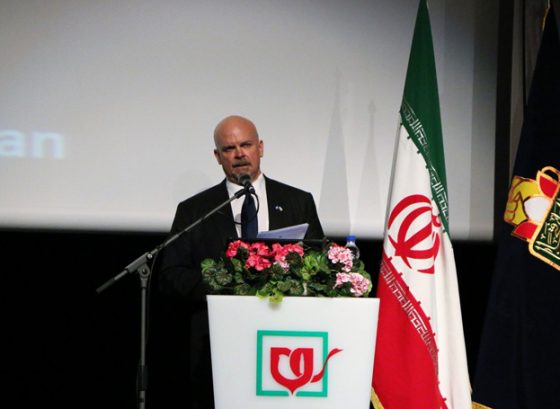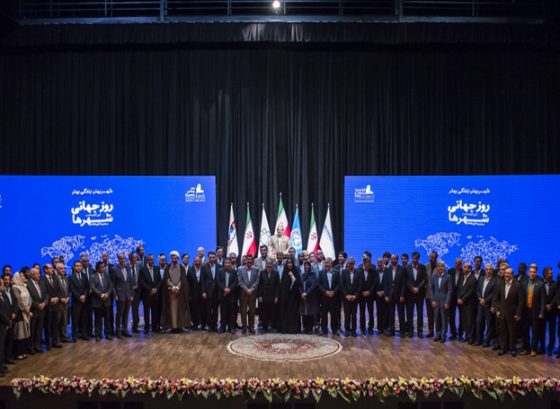Statement of Mr. Gary Lewis, UN Resident Coordinator and UNDP Resident Representative in the I.R. of Iran

Statement of Mr. Gary Lewis, UN Resident Coordinator and UNDP Resident Representative in the I.R. of Iran on the occasion of 10th anniversary celebrations and signing of the UNDP Carbon Sequestration Project Addendum,AVA Diplomatic Reports.5 MAY 2013
Bismillah – hey – Rahman – ur – Rehim,
Salaam va Sobhe be kheyr.
Minister Owrangi,
Distinguishes Governors-General,
Mr. Saedat, representing Ministry of Foreign Affairs,
Hojat al Islam Tabatabaynejad,
Excellencies,
Ladies and Gentlemen,
I am both delighted and honoured to be present here today to commemorate the 10th Anniversary of the Carbon Sequestration project in the Islamic Republic of Iran. Today we will witness its many achievements.
Today we will – together – sign the new Addendum to the project. The project is in its Third Phase now. The new phase will build upon our initial successful experience in Khorassan e Janubi. This is already being piloted in the provinces of Kerman and Tehran. We will now extend our work to many other provinces of Iran – provinces like Alborz, Bushehr, Markazi and Semnan. I am delighted to greet the esteemed Governors-General of these provinces who have travelled from far to be here with us today – and who make this new commitment for our future.
In these opening remarks, please also allow me to convey my warm appreciation to all those staff who have been active in this project during the past 10 years – both those who are among us today and those who have made their contribution and moved on. I wish to convey these good wishes formally through their Excellencies Mr. Owrangi, as Head of the Forest, Range and Watershed Management Organisation, and Mr Ghahreman Rashid, Governor General of Khorassan e Janubi, where our project started it long and successful journey. Our greetings also go to all those actively involved in the Kerman and Tehran provinces including their Governors-General – who are present with us today – for their leadership, support and guidance.
I take the opportunity here to also thank Mr Kargar and his staff in the Desert Bureau which directly oversees this project.
I had the pleasure of spending over two hours with Mr. Kargar recently. During this time, we shared ideas about many things – history, culture and geography – as well as our reflections on leaders like, the Prophet Mohammad (pbuh), Kourosh, and Nelson Mandela. I was honoured that he had taken so much time and effort to learn about the land where I was born and spent my youth – the small island of Barbados in the Caribbean. I tried to convey what little I knew about my new home – Iran. I learnt much from him. He told me that in his view the difference between the possible and the impossible is contained in a single word: willpower. Willpower is what has caused trees to bloom and grow where once there was only desert.
Then, as we concluded our discussion, we agreed that the generation of managers and leaders – represented by many in this room, need to do what we can to preserve what is beautiful on this planet – and what will keep future generations of our children alive and healthy.
For the pressures on our planet are great. Ever larger numbers of people are consuming the earth’s resources. As we consume, we produce more and more carbon emissions. As our planet warms, we face more extreme weather – more water shortages – more acidified oceans – more deforestation – and more desertification.
Iran – indeed – is one of those countries most affected by desertification.
At a global scale, the key to solving all these problems is to both reduce carbon emissions and find ways to absorb the carbon already emitted.
At the national level, Iran has made the rehabilitation of its degraded lands a top priority. And we should be proud of this.
On the ground, during the past few years, the Forest, Rangeland and Watershed Organisation has been undertaking a significant effort – through many projects – to raise the rate of Iran’s carbon sequestration. The Carbon Sequestration Project is one of these initiatives. Through this work we have built feasible working models. And this is what the new phase of the project is meant to re-produce.
What is the model? Initially, it was simply tree-planting and reforestation. But such efforts will wither – quite literally – unless we fully our communities. There is a saying I learnt many years ago – “nothing should be done for us – without us”.
The project was initially designed to demonstrate that desertified rangelands can be reclaimed by local people in a cost-effective way. In the process we were able to empower these communities with choices. We generated small enterprises. We encouraged villagers to participate in reclaiming their own rangelands.
So, this is the model of which we speak today.
I am confident that because we are all working at ground level with local communities, this expansion will be successful. Here I would like to recognize the solid support which the project has received in recent years from the religious authorities, especially the Jomeh Imams – represented here today by Hojatalislam Tabatabaynejad of the Supreme Leader’s Office.
In fact, I would like to see this model brought to the attention of other communities in other countries with similar threats to their rangelands. Recently, the Foreign Minister of Iran – Dr. Salehi – asked me to find ways of expanding Iran’s potential for South-South cooperation in certain areas. And this would be one.
All of this cooperation takes place within the framework of UNDP’s new Country Programme agreement with the Government of the Islamic Republic of Iran. This programme was signed in 2012 and strongly supports the national capacity development process as envisaged in the 5th National Five Year Development Plan capacity development processes – especially those that link natural resource management with human development and inclusive economic growth. If we can rehabilitate the environment we can reduce poverty.
So our project will expand today. Through the signatures we are about to place on the Addendum document, it will grow to include four new District-level sites.
The honourable Governors-General of those four Provinces are present here today to confirm their support for our initiative.
For its part, UNDP will contribute to this joint effort. We will help to build and expand participatory approaches to rangeland rehabilitation management. We will bring the best available expertise – national and international – to solve problems at the local level. In this way, we will also help Iran to implement its obligations under the United Nations Convention to Combat Desertification (UNCCD).
I would therefore like – again – to applaud the work that has already been undertaken by the staff and officials of the Forest, Rangeland and Watershed Organisation. I applaud the Provincial Governorates who have already implemented our Carbon Sequestration Project up to this time.
I am particularly delighted to recognize the members of the rangeland communities who are present here today. I recognize Mr. Naser Abbasi and Mrs. Esmat Hosseini – our prizewinners. I thank you for the great work you have done and the new work you will do with us from today onwards. You possess the knowledge of your own lands. It is you who will leave a healthier, richer environment for your children.
Ladies and Gentlemen, we in the United Nations consider the Carbon Sequestration project to be a very successful partnership. With this new Addendum, the project will continue to achieve greater success.
I join those on the podium here today in wishing the best for the future of this project.
And I pledge the fullest support of the United Nations to our common goals.




